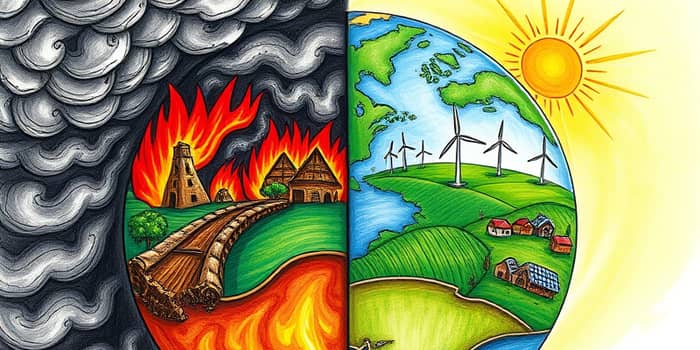
Climate change poses an unprecedented economic challenge worldwide, affecting every sector and region. Understanding both the risks and the potential rewards is essential for businesses, policymakers, and investors. By examining the financial projections, sectoral impacts, system-level concerns, and emerging opportunities, stakeholders can make informed decisions to safeguard assets and capitalize on the shift to a low-carbon future.
Climate-related financial risks fall into three broad categories: physical, transition, and systemic. Each type threatens to disrupt economic stability and growth.
Under a business-as-usual scenario (BAU), global economic losses between 2025 and 2100 are estimated at $2,328 trillion. Limiting warming to 1.5°C could halve those losses to $1,062 trillion, over $1,200 trillion saved compared to BAU. Yet, direct losses capture only part of the story: they exclude stranded assets, biodiversity loss, and social upheaval related to migration or conflict.
The burden of climate change is unevenly distributed. Lower-income countries and regions at lower latitudes—often the least responsible for greenhouse gas emissions—face the highest relative losses, deepening global inequality. Even within high-income nations like the United States, poorer counties may see income declines of 2–20% due to extreme heat and storms.
Key sectors feel the impact acutely:
Financial institutions play a pivotal role in pricing and managing climate risk. Insurers must factor in increased claim frequencies for natural disasters, while banks need robust climate stress tests to assess credit exposure in high-risk industries.
Key actions include:
The transition to a low-carbon economy also unlocks vast opportunity. Mobilizing capital for adaptation and mitigation can spur growth, innovation, and resilience.
Opportunities at a glance:
Investing in climate mitigation and adaptation is a fraction of the economic losses from inaction. To limit warming to 2°C, adaptation and mitigation finance of less than $300 trillion through mid-century is needed—roughly 20% of projected BAU losses.
Every 1°F rise in average temperature could reduce U.S. GDP by 0.7%, excluding increased mortality and labor impacts—highlighting a stark choice. Mitigation costs are outweighed by six times the economic damages avoided through early action.
Central banks and regulators are increasingly embedding climate risk into policy frameworks. Green investment flows have surged, yet capital gaps remain, particularly in developing nations.
Ensuring equitable climate action and risk management means prioritizing funding for vulnerable communities, safeguarding food and water security, and promoting technology transfer. Innovations like catastrophe bonds and blended finance can bridge shortfalls and protect livelihoods.
Climate change economics reveals a clear imperative: act now or face profound financial losses. While the risks span physical damage, policy upheaval, and systemic shocks, the opportunities in green finance, sustainable infrastructure, and innovative policy design are equally monumental.
By mobilizing capital for adaptation infrastructure and aligning investments with a net-zero future, stakeholders can secure long-term returns from early action and protect global prosperity. The path forward demands collaboration across governments, financial institutions, and communities. In this collective endeavor, decisive, informed, and equitable strategies will determine whether we mitigate severe costs or succumb to escalating climate-driven crises.
References













